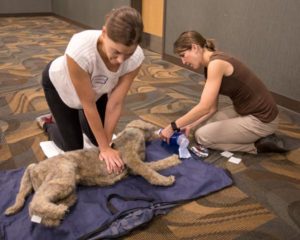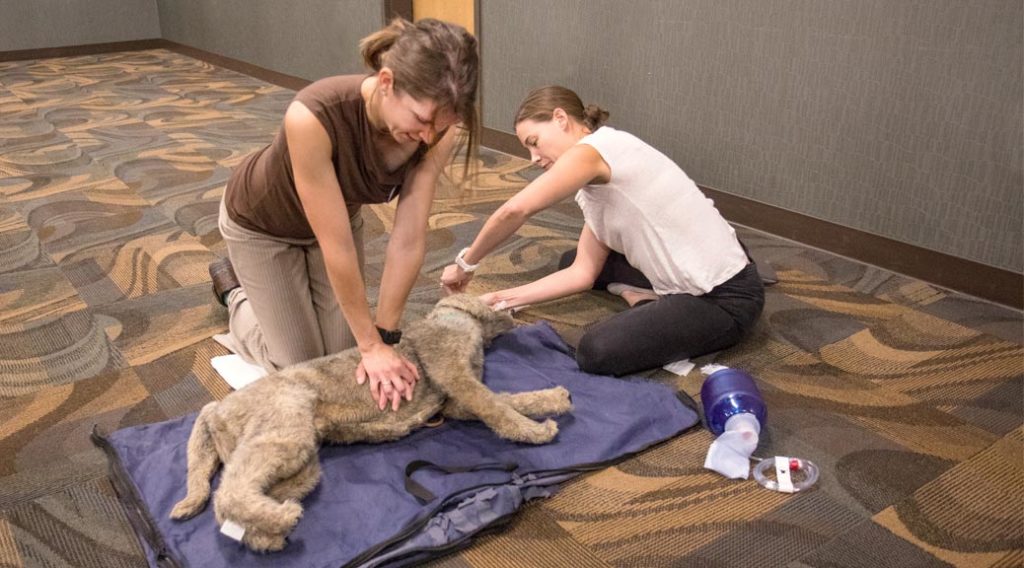Our clinic owner, Dr. Timea H. Brady, recently earned certification to perform cardiopulmonary resuscitation (CPR) on dogs and cats.
Dr. Brady’s certification by the Reassessment Campaign on Veterinary Resuscitation (RECOVER) initiative required 8.5 continuing education hours of online coursework in basic and advanced life support followed by four hours of hands-on training using stuffed dog manikins in a live workshop setting. She completed the requirements on September 19 at Purdue University’s Fall Veterinary Conference, becoming one of approximately 1,000 “Certified RECOVER Rescuers” worldwide.

“My staff wanted to learn more about CPR and how to do it, but I realized I had only very basic knowledge—certainly not enough to teach it,” said Dr. Brady. “When I saw Purdue was offering the course at their Fall Conference, I jumped at the chance to learn so I could improve my patients’ chances of survival as well as teach my entire team the evidence-based best practices.”
Dr. Brady set aside two full staff meetings for CPR training. The October 22 meeting focused on the basic and advanced life support coursework. In a follow-up training session on November 12, the staff will practice CPR techniques on a stuffed animal.
Using handouts, demonstrations and hands-on practice, the training covers how to recognize cardiopulmonary arrest, the CPR procedure itself and post-cardiac arrest care. Dr. Brady has ordered copies of the RECOVER guidelines and emergency drug dosage posters for permanent display in the clinic’s surgery and dental suites and treatment area.
“We’ll be practicing on a stuffed animal, but in the workshop at Purdue, we had dog-shaped CPR dummies called simulators that had an open mouth with teeth and a tongue so we could practice intubating them,” said Dr. Brady. “The simulators were also designed to give realistic resistance when we were doing the chest compressions. Our stuffed animal won’t have those features, but I think it will still be helpful in learning the techniques.”
In keeping with RECOVER recommendations, the clinic has ordered additional supplies for the emergency crash cart, fully stocking it with multiple sizes of endotracheal tubes and IV catheters, a manual resuscitator bag, fluids and emergency drugs such as epinephrine, atropine and naloxone.
“Our cart has just about everything paramedics for humans have on their trucks, but in more different sizes to suit the smallest to the largest pets,” said Dr. Brady. “Our staff training will cover what’s in the crash cart and where, so there will be no delays in accessing the tools and supplies we need during an emergency.”
About Veterinary CPR
Veterinary cardiopulmonary resuscitation (CPR) is called for when an animal’s breathing and heartbeat stop. The causes may include heart disease, metabolic diseases, low levels of oxygen in the blood, electrolyte imbalances, dehydration, adverse reactions to a drug, electrical shock or brain trauma.
The mortality rate is extremely high in veterinary cases of cardiopulmonary arrest (CPA). For animals experiencing CPA while hospitalized, only 1.6 to 6 percent of dogs and 2.3 to 9.6 percent of cats survive to be discharged from the hospital. In humans, approximately 24 percent of adults survive an in-hospital CPA.
CPR is the only treatment of cardiopulmonary arrest. In both animals and humans, the odds of survival after CPA improve with the quality of CPR delivery, including early recognition and response to CPA, skillful application of effective basic and advanced life support techniques and post-cardiac arrest care.
Although one person can administer basic veterinary CPR, alternating between timed chest compressions and breaths, having two people handle both simultaneously makes the procedure easier.
“Once you have an unresponsive dog or cat, it works best to begin immediately with chest compressions, with a second person handling respiration,” said Dr. Brady. “These two can swap places every two minutes, because the chest compressions are tiring, but you want to keep it up until you’ve given the heart a chance to start again on its own.
“If you’re in a hospital setting and your team is trained and available, they can provide advanced life support—things like inserting an IV catheter and administering drugs, intubating and getting the patient hooked up to oxygen and an EKG machine. Team members can also look in the patient’s medical history for health problems or adverse reactions to drugs and write down all that’s being done in the moment to revive the pet so we have it for our records.”
As in human medicine, Dr. Brady said CPR alone doesn’t always restart a cat or dog’s heart, and even if it does, long-term survival is far from guaranteed. “With CPR, we’re mainly trying to buy time and keep oxygenated blood flowing to the brain and heart in hopes of a successful resuscitation with minimal tissue damage. Ideally, if CPR works, the heart starts back up and you get them breathing again. If you can do that, you then have a chance to diagnose the problem and try to solve it.
“You have the best chances of a successful result when CPR’s a team effort, and what you’re doing is based on current, evidence-based best practices. That’s why I’m excited to pass on to my entire staff what I learned to get certified.”
About the RECOVER Initiative
The RECOVER initiative is a non-profit, volunteer effort undertaken in 2010 by the American College of Veterinary Emergency and Critical Care and the Veterinary Emergency and Critical Care Society. More than 100 board-certified veterinary medical specialists spent 18 months systematically reviewing the experimental and clinical evidence in CPR research and devised evidence-based, consensus CPR guidelines for dogs and cats. The organization published its first RECOVER guidelines in 2012 and, based on its continuing work, anticipates publishing revised guidelines in 2020.
So far, about 9,000 veterinarians, veterinary technicians, veterinary nurses and students worldwide have completed the RECOVER online course. In addition to about 1,000 certified RECOVER Rescuers, there are about 190 certified RECOVER instructors qualified to lead certification workshops and labs.
Although the guidelines have been available since 2012, RECOVER Initiative Program Director Kenichiro Yagi said, “RECOVER is at its initial stages of adoption by the veterinary field. Progressive individuals and practices wanting to adopt the best evidence-based practice in veterinary CPR are the ones who find RECOVER.”
“We don’t have data to show whether the guidelines have led to increased survival,” said RECOVER Initiative Co-Chair Daniel J. Fletcher, PhD, DVM and Diplomate of the American College of Veterinary Emergency and Critical Care. “Until we have data to share, what we can say is that folks who complete the RECOVER certification process report feeling much more confident and less stressed when an arrest occurs and feel that they are now more prepared when an arrest happens. So we’re making some progress!”
“Until the RECOVER initiative, there were no published standards or guidelines about veterinary CPR, and that led to a wide range of approaches and I’m sure, a lot of chaos, too,” said Dr. Brady. “What veterinarians and technicians did know was often adapted from human protocols, and it turns out what works for humans doesn’t always work for dogs and cats.
“Fortunately, in general practice, cases of cardiopulmonary arrest are relatively rare. I’ve encountered fewer than a half-dozen or so in my 15 years as a general practitioner. Of course, every one of those cases was pretty stressful.
“Now, as a result of this training, my team and I will be prepared to recognize common cardiopulmonary arrest warnings, we’ll all know the evidence-based treatment strategies and proper drug doses to use and how best to care for surviving patients after CPR. I’m sure we’ll feel calmer and more confident, should we need to resuscitate a patient, and the animal’s chances of survival will improve.
“I feel empowered now! There is no longer any guesswork. I know what to do. No more chaos!”
To maintain certification, Dr. Brady will be required to take a comprehensive online course every two years. RECOVER CPR is the only official veterinary CPR certification recognized by the American College of Veterinary Emergency and Critical Care and the Veterinary Emergency and Critical Care Society.
For information about RECOVER certification programs for veterinary professionals, first responders and pet care professionals, and pet owners, visit the RECOVER Initiative website.

